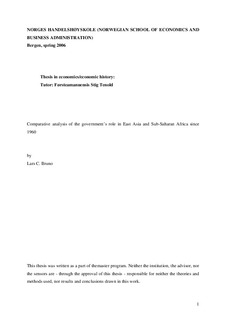Comparative analysis of the government’s role in East Asia and Sub-Saharan Africa since 1960
Master thesis
Permanent lenke
http://hdl.handle.net/11250/167547Utgivelsesdato
2006Metadata
Vis full innførselSamlinger
- Master Thesis [4378]
Sammendrag
This thesis looks at the differences in economic growth between Sub-Saharan Africa and East Asia in the time period from 1960 until today. Three major causes are assessed which all are attempted linked to the government’s role; i) Structural causes; ii) Economic policy; and iii) Institutional causes. The main results indicate that Sub-Saharan Africa suffered from worse structural effects than East Asia; and that East Asia had a more favourable institutional environment. The role of economic policies remains controversial and partly unresolved, which goes especially for the role of industrial and trade policies. My main findings confirm those by a number of scholars; i) A high state capacity promoted economic growth through economic policies and institutional innovations in East Asia; and ii) Sub-Saharan Africa had a low state capacity which hampered economic growth and the state capacity was weakened even further due to increased donor involvement.
